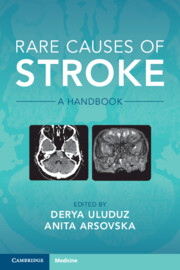Book contents
- Rare Causes of Stroke
- Rare Causes of Stroke
- Copyright page
- Contents
- Contributors
- Preface
- 1 Inflammatory Conditions
- 2 Infectious and Postinfectious Vasculitis
- 3 Hypercoagulable Causes of Stroke
- 4 Drug-Related Stroke
- 5 Hereditary and Genetic Causes of Stroke
- Chapter 5.1 Genetic Collagen Disorders
- Chapter 5.2 Genetic Small-Vessel Diseases
- Chapter 5.3 Genetic Metabolic Diseases
- Chapter 5.3 Chapter
- 6 Rare Causes of Cardioembolism
- 7 Vasospastic Conditions and Other Vasculopathies
- 8 Other Non-inflammatory Vasculopathies
- 9 Venous Occlusive Conditions
- 10 Bone Disorders and Stroke
- Index
- References
Chapter 5.3 - Chapter
from 5 - Hereditary and Genetic Causes of Stroke
Published online by Cambridge University Press: 06 October 2022
- Rare Causes of Stroke
- Rare Causes of Stroke
- Copyright page
- Contents
- Contributors
- Preface
- 1 Inflammatory Conditions
- 2 Infectious and Postinfectious Vasculitis
- 3 Hypercoagulable Causes of Stroke
- 4 Drug-Related Stroke
- 5 Hereditary and Genetic Causes of Stroke
- Chapter 5.1 Genetic Collagen Disorders
- Chapter 5.2 Genetic Small-Vessel Diseases
- Chapter 5.3 Genetic Metabolic Diseases
- Chapter 5.3 Chapter
- 6 Rare Causes of Cardioembolism
- 7 Vasospastic Conditions and Other Vasculopathies
- 8 Other Non-inflammatory Vasculopathies
- 9 Venous Occlusive Conditions
- 10 Bone Disorders and Stroke
- Index
- References
Summary
Menkes disease (MD) is a rare and lethal infantile neurodegenerative multisystemic disorder of copper metabolism, inherited as an X-linked recessive trait. In classic MD, patients have a serious clinical progression, with death in early childhood. MD occurs due to mutations in the ATP7A gene. Initial MD diagnosis is pointed out by clinical features, namely, the distinctive hair, and supported by reduced serum copper and ceruloplasmin levels. Lysyl oxidase is a copper-dependent enzyme implicated in collagen and elastin cross-linking and vascular architecture formation. Dysfunction of this protein in MD leads to anomalous vessel structure and tortuosity. Both haemorrhagic and ischemic stroke have been reported. Bilateral ischaemic lesions in deep grey matter, or in the cortical areas, as consequence of brain infarcts have been documented. MD treatment is mostly symptomatic with parenterally or subcutaneous injections of copper-histidine Antithrombotic therapy may be considered
- Type
- Chapter
- Information
- Rare Causes of StrokeA Handbook, pp. 262 - 266Publisher: Cambridge University PressPrint publication year: 2022

